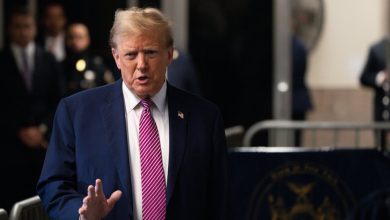How the Computer Chip Shortage Could Incite a U.S. Conflict With China

WASHINGTON — The war game scenario conducted by a Washington think tank began with a sudden failure at three Taiwanese semiconductor foundries that make high-end computer chips used in such items as smartphones, automobiles and military equipment.
The halt in production raised questions of whether a cyberattack by Beijing was responsible — touching off an international crisis between China and the United States that the researchers said could grind the global economy to a halt and incite a military confrontation.
The war game and study by the Center for a New American Security, which is set to be released on Thursday, illustrate how dependent the world is on Taiwanese computer chips — and how that dependence could draw the United States and China into various kinds of conflict.
The report comes as Congress has put new energy into bills to increase domestic production of semiconductors in the United States. Diversifying the global supply chain for computer chips is a key recommendation in the report.
Last week, President Biden urged Congress to pass those bills and promised he would work to bring production of semiconductor chips back to the United States.
“Today we barely produce 10 percent of the computer chips, despite being the leader in chip design and research,” Mr. Biden said. “And we don’t have the ability to make the most advanced chips now — right now. But today, 75 percent of production takes place in East Asia. Ninety percent of the most advanced chips are made in Taiwan. China is doing everything it can to take over the global market so they can try to outcompete the rest of us and have a lot of applications — including military applications.”
Even if Congress approves new government investments in America’s microchip production capacities, matching Taiwanese expertise is years away, if it is even possible, the report’s authors say. The United States is already more dependent on Taiwan’s high-end microchips than it was on Middle Eastern oil in decades past, the report said.
Understand the Supply Chain Crisis
- The Origins of the Crisis: The pandemic created worldwide economic turmoil. We broke down how it happened.
- Explaining the Shortages: Why is this happening? When will it end? Here are some answers to your questions.
- Lockdowns Loom: Companies are bracing for more delays, worried that China’s zero-tolerance Covid policy will shutter factories and ports.
- A Key Factor in Inflation: In the U.S., inflation is hitting its highest level in decades. Supply chain issues play a big role.
China, the war game predicts, could use economic coercion, cyberoperations and hybrid tactics to try to seize or harm Taiwan’s semiconductor industry — and the United States must become better able to identify and counter Chinese tactics that could threaten the microchip supply.
War games like this one involve current and former officials, academics and other experts sitting around a table playing various roles. After an initial scenario is presented, the teams take turns making strategic decisions. Such exercises are supposed to yield insights about how different players would act, and lay plain what sort of moves each group might make.
Becca Wasser, who helped design and lead the scenario, said while many war games were conducted to study China, most focus on conventional military threats, giving short shrift to the many ways China could exert pressure on Taiwan.
And countering those pressure points is difficult, especially if the United States and Taiwan are at odds over the best strategy. In the scenario, the U.S. team presumed the Taiwan team would go along with its strategies to counter China. But Taiwan’s interest sometimes led it to cross-purposes. For example, when the United States wanted to bring semiconductor engineers to the safety of America, Taiwan resisted, worried about a brain drain.
“Whatever the United States tried to do by itself in the game really fell flat,” Ms. Wasser said. “We have seen a variety of examples of that in real life.”
As a result, multilateral responses and global efforts to build resiliency in the supply chain for computer chips are most likely the best strategy, the report said.
Taiwan has relied on its dominance of the microchip industry for its defense. The “silicon shield” theory argued that because its semiconductor industry is so important to Chinese manufacturing and the United States consumer economy, actions that threaten its foundries would be too risky.
Martijn Rasser, a co-author of the study and a former C.I.A. analyst, said it was crucial for the international community to convince Taiwan that its shield strategy needed to be internationalized. “The long-term play has to be a geographic dispersal of those capabilities out of Taiwan in exchange for enhanced security guarantees for the island,” he said.
How the Supply Chain Crisis Unfolded
The pandemic sparked the problem. The highly intricate and interconnected global supply chain is in upheaval. Much of the crisis can be traced to the outbreak of Covid-19, which triggered an economic slowdown, mass layoffs and a halt to production. Here’s what happened next:
A reduction in shipping. With fewer goods being made and fewer people with paychecks to spend at the start of the pandemic, manufacturers and shipping companies assumed that demand would drop sharply. But that proved to be a mistake, as demand for some items would surge.
Demand for protective gear spiked. In early 2020, the entire planet suddenly needed surgical masks and gowns. Most of these goods were made in China. As Chinese factories ramped up production, cargo vessels began delivering gear around the globe.
Then, a shipping container shortage. Shipping containers piled up in many parts of the world after they were emptied. The result was a shortage of containers in the one country that needed them the most: China, where factories would begin pumping out goods in record volumes
Demand for durable goods increased. The pandemic shifted Americans’ spending from eating out and attending events to office furniture, electronics and kitchen appliances – mostly purchased online. The spending was also encouraged by government stimulus programs.
Strained supply chains. Factory goods swiftly overwhelmed U.S. ports. Swelling orders further outstripped the availability of shipping containers, and the cost of shipping a container from Shanghai to Los Angeles skyrocketed tenfold.
Labor shortages. Businesses across the economy, meanwhile, struggled to hire workers, including the truck drivers needed to haul cargo to warehouses. Even as employers resorted to lifting wages, labor shortages persisted, worsening the scarcity of goods.
Component shortages. Shortages of one thing turned into shortages of others. A dearth of computer chips, for example, forced major automakers to slash production, while even delaying the manufacture of medical devices.
A lasting problem. Businesses and consumers reacted to shortages by ordering earlier and extra, especially ahead of the holidays, but that has placed more strain on the system. These issues are a key factor in rising inflation and are likely to last for months — if not longer.
The Biden administration has made clear that in the case of Ukraine, while the United States would economically punish Russia for any invasion, it would not commit troops to fight alongside Kyiv to stop any intervention by Moscow. The longstanding American policy toward Taiwan calls for shoring up its defenses and practicing strategic ambiguity over whether Washington would militarily intervene in a conflict over the island.
But Taiwan and its semiconductors are far more important to America’s economy than Ukraine is — meaning it would very likely be far more difficult for the United States to stay out of a conflict involving Taiwan.
Taiwan accounts for half of the overall production of microchips that are critical to the functioning of mobile phones, consumer electronics, cars, military equipment and more. South Korea, the nearest competitor, has about 17 percent of the overall market. But Taiwanese chips are the smallest and fastest, and its foundries account for 92 percent of the most advanced designs.
“It’s almost impossible to duplicate Taiwan’s manufacturing capability of high-end chips, of low-end chips,” said Dan Blumenthal, a scholar at the American Enterprise Institute. “It’s just the manufacturing hub of the world.”
Although the United States and Europe are trying to boost their own domestic design and production of semiconductors, they do not have the abilities to mass produce the most advanced designs that the Taiwan Semiconductor Manufacturing Company, or TSMC, can make.
“If the semiconductor supply chain is infringed upon by China in some way, all of the sudden the things that Americans look to in their daily lives, to get to and from work, to call their loved ones, to do a variety of different things, those disappear,” Ms. Wasser said.
Other experts said it would be an overstatement to say that the United States would be dragged into a war over microchips. China will decide what kinds of coercive measures it will take against the Taiwanese based on the perceived threat to its sovereignty and the expected international backlog, said Bonny Lin of the Center for Strategic and International Studies.
“China is not going to base their Taiwan policy, or any decision to use force against Taiwan, based on chips,” Dr. Lin said. “China thinks about the costs of an invasion of Taiwan — there are significant political and military costs. That is why I don’t think chips would figure among the top three factors of using military force against Taiwan.”




